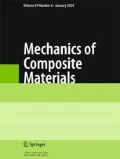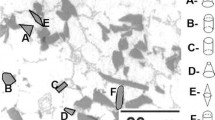The main focus of the present paper is the estimation of the macroscopic stress–strain behavior of a particulate composite. A composite with a cross-linked polymer matrix in a rubbery state filled with an alumina-based mineral filler is investigated by means of the finite-element method. The hyperelastic material behavior of the matrix is described by the Mooney–Rivlin material model. Numerical models on the basis of unit cells are developed. The existence of a discontinuity (breaking) in the matrix at higher loading levels is taken into account to obtain a more accurate estimate for the stress–strain behavior of the particulate composite investigated. The numerical results obtained are compared with an experimental stress–strain curve, and a good agreement is found to exist. The paper can contribute to a better understanding of the behavior and failure of particulate composites with a polymer matrix.






Similar content being viewed by others
References
C. J. Sun, W. Wu, S. Mahanti, K. Sadeghipour, G. Baran, and S. Debnath, “Finite element analysis of toughtening for a particle-reinforced composite,” Polym. Composite, 27, No. 4, 360–367 (2006).
C. J. Sun, P. Saffari, R. Ranade, K. Sadeghipour, and G. Baran, “Finite element analysis of elastic property bounds of a composite with randomly distributed particles,” Compos. Pt. A-Appl. Sci. Manuf., 38, 80–86 (2007).
B. Banerjee, D. O. Adams, “Micromechanics-based determination of effective elastic properties of polymer bonded explosives,” Physica B, 338, 8–15 (2003).
M. Böl, S. Reese, “Finite element modeling of rubber-like materials – a comparison between simulation and experiment,” J. Mater. Sci., 40, 5933–5939 (2005).
T. Iung and M. Grange, Letter “Mechanical behaviour of two-phase materials investigated by the finite element method: necessity for three-dimensional modeling,” Mater. Sci. Engng., A201, L8–L11 (1995).
H. P. Gänser, F. D. Fischer, and E. A. Werner, “Large-strain behavior of two-phase materials with random inclusions,” Comp. Mater. Sci., 11, 221–226 (1998).
N. Chawla, R. S. Sidhu, and V. V. Ganesh, “Three-dimensional visualization and microstructure-based modeling of deformation in particle-reinforced composites,” Acta Mater., 54, 1541–1548 (2006).
P. R. Marur, “Estimation of effective elastic properties and interface stress concentrations in particulate composites by unit cell methods,” Acta Mater., 52, 1263–1270 (2004).
W. Han, A. Eckschlager, and H. J. Böhm, “The effects of three-dimensional multi-particle arrangements on the mechanical behavior and damage initiation of particle-reinforced MMCs,” Compos. Sci. Technol., 61, 1581–1590 (2001).
H. Shen and C. J. Lissenden, “3D finite element analysis of particle-reinforced aluminum,” Mater. Sci. Engng. A338, 271–281 (2002).
J. LLorca and J. Segurado, “Three-dimensional multiparticle cell simulations of deformation and damage in spherereinforced composites,” Mater. Sci. Eng. A365, 267–274 (2004).
K. Matouš, H. M. Inglis, X. Gu, D. Rypl, T. L. Jackson, and P. H. Geubelle, “Multiscale modeling of solid propellants: From particle packing to failure,” Compos. Sci. Technol., 67, 1694–1708 (2007).
C. J. Sun, P. Saffari, K. Sadeghipour, and G. Baran, “Effects of particle arrangement on stress concentrations in composites,” Mater. Sci. Eng. A 405, 287–295 (2005).
C. R. Chen, S. Y. Qin, S. X. Li, and J. L. Wen, “Finite element analysis of the effects of particle morphology on the mechanical response of composites,” Mater. Sci. Engng. A278, 96–105 (2000).
X. Wang, K. Xiao, L. Ye, Y. W. Mai, C. H. Wang, and L. R. F. Rose, “Modelling the mechanical properties of core-shell rubber-modified epoxies,” Acta Mater., 48, 579–586 (2000).
X. Zeng, H. Fan, and J. Zhang, “Prediction of the effects of particle and matrix morphologies on Al2O3 particle/polymer composites by the finite element method,” Comp. Mater. Sci., 40, 395–399 (2007).
J. Cho, M. S. Joshi, and C. T. Sun, “Effect of inclusion size on the mechanical properties of polymeric composites with micro- and nanoparticles,” Compos. Sci. Technol., 66, 1941–1952 (2006).
P. Hutař, Z, Majer, L. Náhlík, L. Šestáková, and Z. Knésl, “Influence of particle size on the fracture toughness of a PP-based particulate composite,” Mech. Compos. Mater., 45, No. 3, 281–286 (2009).
P. Hutař, L. Náhlík, Z. Majer, and Z. Knésl, “The effect of an interphase on micro-crack behaviour in polymer composites,” Computational Modelling and Advanced Simulations, Vol. 24, Eds. Murín, J., Kompiš, V., Kutiš, V., Springer Science + Bussines Media, 83–97 (2011).
J. Segurado, C. Gonzáles, and J. LLorca, “A numerical investigation of the effect of particle clustering on the mechanical properties of composites,” Acta Mater., 51, 2355–2369 (2003).
L. R. G. Treloar, The Physics of Rubber Elasticity, Oxford University Press, Oxford, third edition (2005).
T. Kawamura, K. Urayama, and S. Kohjiya, “Multiaxial deformations of end-linked poly(dimethylsiloxane) networks 5. Revisit to Mooney–Rivlin approach to strain energy density function,” J. Soc. Rheology, Japan, 31, No. 4, 213–217 (2003).
Acknowledgement
This work was supported through the Grant No.106/08/1409 of the Czech Science Foundation and through the Specific academic research grant of the Ministry of Education, Youth, and Sports of the Czech Republic No. FAST-FCH-FSI-S-11-1 provided to Brno University of Technology, Faculty of Mechanical Engineering.
Author information
Authors and Affiliations
Corresponding author
Additional information
Russian translation published in Mekhanika Kompozitnykh Materialov, Vol. 47, No. 6, pp. 893-902, November-December, 2011.
Rights and permissions
About this article
Cite this article
Náhlík, L., Hutař, P., Dušková, M. et al. Estimation of the macroscopic stress-strain curve of a particulate composite with a crosslinked polymer matrix. Mech Compos Mater 47, 627–634 (2012). https://doi.org/10.1007/s11029-011-9242-6
Received:
Revised:
Published:
Issue Date:
DOI: https://doi.org/10.1007/s11029-011-9242-6




